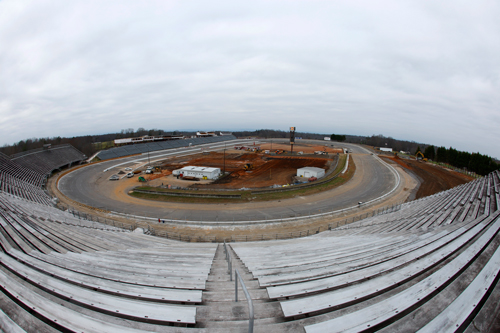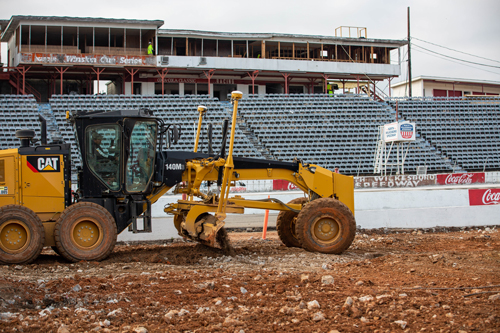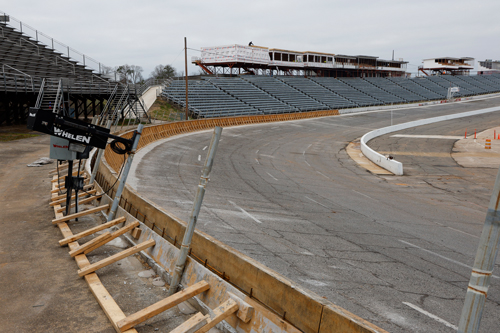SEMA News—March 2023
BUSINESS
By Mike Imlay
Saving North Wilkesboro Speedway
A Case Study in Resurrecting a Racing Venue Once Given Up for Lost
There was a time when the North Wilkesboro Speedway was a renowned mecca of American motorsports. With roots in the moonshine racing that helped birth NASCAR, the 0.625-mi. short-oval dirt track opened May 18, 1947, about 5 mi. east of North Wilkesboro, North Carolina.
Back then, the oval was owned by Enoch Staley and partners Lawson Curry, and Jack and Charlie Combs. Its first official event—promoted by the legendary Bill France—drew more than 10,000 fans, surpassing all expectations. From there, the speedway quickly rose in popularity, due in large part to its unique uphill and downhill stretches and the intense, high-speed racing they delivered.

Weathered by time, North Carolina’s historic North Wilkesboro Speedway once seemed lost to racing—until a successful partnership of racing fans, track ownership, business leaders and public officials united to save it. This May, it will host the NASCAR All-Star Race.
In 1949, the speedway began hosting NASCAR Cup Series racing. That year, Robert “Red” Byron was crowned the first NASCAR champion on October 16. He is just one of the countless historic drivers who have powered through the North Wilkesboro oval over the years—greats like Kenneth Wagner, Fireball Roberts, the Flock Brothers, Junior Johnson, Richard Petty, Bobby Allison, among others.
Throughout its heyday, the track saw scant upgrades. Although it was paved in the ’50s, its owners never invested in the sorts of facilities renovations undertaken at other tracks. At North Wilkesboro, it was the hardcore racing action that drew the crowds, not the amenities. For fans, it was a timeless community landmark supporting the area’s rural economy. (Today, Wilkes County is home to an estimated 65,000-plus inhabitants.)
But by the ’90s the track was sputtering. Economic factors, the facility’s age and changes in ownership all played a role. After hosting its last Winston Cup Series event in 1996, the speedway went dark, with little hope of a comeback. Sure, there were a few ill-fated attempts to revive it in the early ’00s, but after 2011 the track sat essentially lifeless, home only to cracking pavement, decaying infrastructure and weeds.
Or so it seemed. Thanks in good measure to the vision of a far-flung network of motorsports enthusiasts, track-owner Speedway Motorsports and NASCAR recently announced that, as part of NASCAR’s 75th anniversary season, the NASCAR All-Star Race will be held at North Wilkesboro Speedway this May 21. The race will cap off a three-day weekend of series racing at the speedway, which begins Friday, May 19.
The Return to Glory
“The NASCAR All-Star Race has always been the fans’ race, and I can’t think of a better way to celebrate the fans during NASCAR’s 75th anniversary than returning to North Wilkesboro Speedway,” said Marcus Smith, president and CEO of Speedway Motorsports, the track’s current owner. “We couldn’t have made this happen without tremendous support from so many people including Governor [Roy] Cooper, our state legislature, NASCAR, Dale Earnhardt Jr., and of course, the people of Wilkes County. We’ve got a lot of work to do, but we’ve got the will to create something special alongside a community and hard-working staff that will get it done.”

And that work will be well-supported. In November 2021, an $18 million allocation from federal American Rescue Plan funds was designated for infrastructure improvements through the North Carolina state budget, and Wilkes County has awarded construction contracts for the forthcoming work. In addition, the state’s General Assembly agreed in principle to provide a $4-million economic grant this year toward additional facility improvements to host the 2023 NASCAR All-Star Race and other special events down the line.
“The future of North Wilkesboro Speedway is bright,” Smith said. “There is a great opportunity to revive this fantastic venue to be, not just a racetrack, but a place that can host lots of events, a place that people will come to from far away and enjoy the community, enjoy the region and enjoy special events.”
It’s a historic turnaround for a track that promoters tout as “one of stock car racing’s most storied venues.” In fact, the speedway’s comeback offers a case study in what grassroots activism combined with ownership, government and sanctioning-body cooperation can accomplish—and may well be a template for preserving other racing venues across the nation.
Although no one knows the actual number of endangered racing facilities, there is a general industry sense that the recent pandemic may have added to the stress factors that tracks have already been facing for some time. Performance Racing Industry (PRI) Track Ambassador Tom Deery, who has been keeping an eye on the trend, characterizes the problem as one of ongoing and persistent pressures that are taking a toll on facilities throughout the United States.
“There’s always going to be an issue that will pop up,” he said. “The challenge that most motorsports facilities have is they used to be out in the country or they used to be remote, and [with] many of the places that are being targeted right now, the community has grown up around them or near them, and that has created a whole new dynamic.”
For most of these tracks, as urban landscapes grew, “all of a sudden people began to complain,” explained Deery. “In a general sense, a motorsports facility is always going to be a target of someone. They create noise. They create traffic. They create activity. They create a thousand things that somebody within their universe doesn’t like. And if they’re not a motorsports fan, then they will always be that person that’s raising their hand saying, ‘Why are we doing this? What are we doing? How can we stop this?’”
Should tracks continue to shutter, the closures could have vast consequences for grassroots racing and, ultimately, higher-level motorsports. However, Deery noted that PRI and the racing industry at large are making real progress in addressing the issue.
The Grassroots Factor
Which brings us back to the North Wilkesboro Speedway, whose path to reopening was greased in no small part by Save the Speedway, a grassroots organization co-founded in 2005 by racing nostalgia fans Robert Marsden and Steven Wilson.

“Robert kind of started this effort because many years ago on his way south, he remembered that the speedway was still there,” explained Wilson. “He stopped in, saw the place out there, thought it [still] had a lot of potential, and started doing some research.”
Wilson, who was also researching historic auto racing at the time, likewise became enamored with the speedway’s past. He learned that while there had been prior petition drives to save the North Wilkesboro oval, they had either proven disorganized or unrealistic in their approach. But once he connected with Marsden online, all that changed.
“We started [Save the Speedway] independently, really to answer two questions: First and foremost, what would it take to reopen the speedway? And then if we were to reopen the speedway, after all those things that needed to happen first, who would even come race there and what events would come there?”
It wouldn’t be easy. There was a significant learning curve and a lot of hard work ahead of them. Prior discussions among local officials and track owners had ended in unproductive stalemates and built-up animosity.
“What stuck with us [was] there was such an investment in trying to force [track ownership] to do something instead of trying to find ways to work with them. Over time, those ideas have changed, and we feel like we’ve been a part of that,” said Wilson.
Plus, Save the Speedway had something that earlier initiatives lacked—digital reach that could enlist a legion of diverse supporters, many from places far beyond North Carolina, including foreign countries.
“Our group is geographically dispersed,” he explained. “The funny thing is probably the number-one question that we get is, ‘Are you from Wilkes County?’ And most people are very surprised at the fact of no, I’m not from Wilkes County. But I’m from a very similar town in Virginia that is economically depressed. It’s a very rural area that has opportunities that are very limited in nature. And I see a lot of my town in Wilkes County.”
“This was a totally 100% a grassroots effort,” he added. “We had no advertising budget. We had no connections other than using social and digital to promote this effort, not only very early on in 2005 when this started, but even today.”
Moreover, other than being fans of the sport, Save the Speedway volunteers had no real racing connections. But leveraging the internet, Facebook and other social media, they dug in and forged the needed relationships through sheer determination. “We built Save the Speedway up over the years, and we went from being the outsiders to being the ones with a seat at the table,” Wilson explained.
The organization helped galvanize local support for the racing facility, including securing buy-in from local officials—and, when necessary, supporting the election of political candidates more favorable to reopening the track. The goal, said Wilson, was to identify people in positions of authority in all walks of life who could push change while deescalating the adversarial tensions that had characterized prior efforts.
Over time, discussions between track ownership and business and civic leaders gained momentum. Soon, supporters of all stripes were pitching in, including racing legend Dale Earnhardt Jr., who in 2019 led volunteers in cleaning the venue so it could be scanned into the iRacing platform. (“Some of my best memories as a little boy were going to North Wilkesboro,” he would recall. “And it got even better when I raced there as a teenager.”)
With that groundswell of support, Speedway Motorsports was able to announce the return of grassroots racing events in April 2022, and Smith laid out his vision for full raceway restoration.
“Water, sewer, electricity, roads, connectivity—those are a lot of the building blocks that we need to get done,” he said. “We want to keep the character of the property, celebrate the history, but, of course, make it safe, convenient and enjoyable for everyone who comes to visit. In the car world, I would call it a restomod. It’s going to look old, but it’s going to work new.”
State government also threw itself behind the program. Following a tour of the track in May 2022, North Carolina Governor Roy Cooper reconfirmed the importance of motorsports to the state’s economy. “North Carolina’s speedways are strong economic drivers for communities across the state that bring friends, families and neighbors together for a rip-roaring good time,” he said. “North Wilkesboro Speedway is just one of many racetracks that will be able to cross the finish line on much-needed repairs with [state] funds. Racing in North Carolina is back and here to stay.”
There are tangible signs that this is more than rhetoric. County infrastructure and access routes to the venue are currently undergoing improvement, adding to Smith’s optimism for the future.
“Bringing back races, bringing back special events, bringing back tourism, creating a very special place where the community can gather, it’s exciting,” he said. “When you think about nostalgic opportunities, this is one of those one-in-a-million opportunities.”
Smith also credited community support for the turnaround. “Anybody might have said this place is too far gone, but this community rallied and brought it to a place where we can rebuild it and it can be a fantastic jewel,” he said.
For his part, Wilson says the Save the Speedway organization will stay focused on North Wilkesboro, supporting the racing events planned for 2023 and ongoing restoration efforts. He added that he is proud of the role that grassroots fans played alongside others to revive the track.
“We were just a group of people that came together,” he observed. “We were just people that were interested in racing, people that remember racing during that time period, and wondered where things went and why they went away. And, you know, the deeper we dug, the more we found there was opportunity to work together.”
A Hotline for Troubled Tracks
Although not involved with the rescue of North Wilkesboro Speedway, PRI has created a hotline for racing venues facing difficulties or closure. According to PRI Track Ambassador Tom Deery, the hotline team has developed a comprehensive plan to help preserve and reopen venues, build coalitions, and offer support for dealing with issues or regulations that may adversely affect racing facilities. To access this help, call 202-847-6593 or email racinghelp@performanceracing.com.






